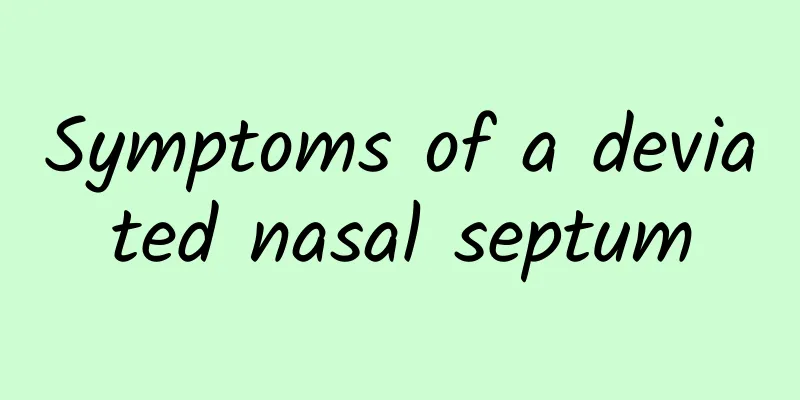Symptoms of a deviated nasal septum

|
Nasal septum deviation is a common disease at present, which has a great impact on people's health. The main symptom is nasal congestion, which will cause patients to have difficulty breathing, loss of sense of smell, deafness and tinnitus. Patients must adjust slowly in normal times. If headaches occur, most of them are caused by nerve compression, which requires massage and medication to relieve, speed up the recovery of the disease, and prevent repeated aggravation of the disease. Symptoms and signs vary depending on the degree, type, and location of the nasal septum deviation. Nasal congestion is the most common symptom, and the obstruction may cause breathing difficulties, loss of smell, deafness, tinnitus, etc. 1. Nasal congestion is the most common symptom. It first occurs on the deviated and protruding side, causing difficulty in breathing at ordinary times, and may be completely blocked when exposed to cold or a cold. The contralateral nasal cavity is initially unobstructed, but over time, due to the physiological space-filling function, the mucosa and nasal concha become compensatory and thickened, causing the nasal cavity to become smaller, resulting in bilateral nasal congestion. 2. Increased nasal secretions. A deviated nasal septum can change the physiological function of the nose, stimulate the glands, and increase nasal secretions. Due to nasal congestion, the large amount of water normally secreted by the nasal mucosa cannot evaporate through breathing air, resulting in increased nasal discharge. If there is a secondary infection that irritates the nasal mucosa, the secretory function will be hyperactive, and the nasal discharge will increase even more. The secretions are mostly viscous or mucopurulent. If there is a sinus infection, there will be a large amount of purulent secretions. 3. Headache is mainly caused by stimulation of the trigeminal nerve endings distributed in the nasal mucosa. It can also reflect along the nerves to the head and face, causing forehead and temporal pain. This pain can be relieved by nasal mucosal retraction or surgery. The causes of headaches include: (1) Mechanical compression: The convex surface of the deviated nasal septum compresses the turbinate mucosa, causing reflex head and facial pain. The calcar and ridge processes compress the turbinate mucosa and are a potential cause of chronic pain in the head and face. (2) Airflow stimulation: Under normal circumstances, air flows from the anterior nostril through the common nasal passage, with most of it entering the posterior nostril along the inner side of the middle and inferior nasal conchae, and only a small part entering the middle and superior nasal passages. When the nasal septum is deviated, most of the airflow may flow into the upper and middle nasal passages, forming a vortex. The cold air over-stimulates the nerve endings and causes a reflex headache. (3) Sinus obstruction headache: The high and deviated nasal septum narrows the middle and upper nasal passages on one side, blocking sinus ventilation and drainage. It often induces sinus infection and swelling of the sinus mucosa, causing severe headaches. If acute frontal sinusitis is induced, the headache is often cyclical. 4. Dizziness often accompanies headaches, sometimes it is masked by headaches and is not noticeable, but it can also occur alone. It is a neurological reflex. Symptoms are obvious when you are cold or have a cold. 5. Olfactory impairment: The high and deviated nasal septum blocks the olfactory groove, preventing olfactory substances in the air from reaching the olfactory area, resulting in respiratory hyposmia. If the olfactory area is blocked for a long time and concurrently with sinus infection, the olfactory nerve endings will be subjected to long-term inflammatory stimulation and degenerative changes may occur, leading to neurological anosmia or hyposmia. 6. Nosebleeds The convex front end of the nasal septum, or the thin mucosa on the surface of the ridge, is directly stimulated by air and dust. Over time, the mucosa becomes dry and scabbed, and is very easy to bleed. Just wiping the nose lightly, or lowering the head and exerting force, can cause repeated nosebleeds. It is also said that the concave surface of the nasal septum near the bottom of the nose is often the place where bleeding occurs. |
<<: Can I eat preserved egg and lean meat porridge when I have a cold?
>>: Dandelion side effects and contraindications
Recommend
What can you eat to remove dampness during the dog days?
The arrival of the dog days heralds the arrival o...
What is the reason for the transparent gelatinous substance in the stool?
When the human intestine is affected, the shape o...
What should pregnant women do if they have pharyngitis? What should we pay attention to?
During the pregnancy stage, pregnant women's ...
Both ankles are swollen. What's going on?
Swelling of both ankles is generally ruled out as...
What to do if there is a hole in the tooth
There are many teeth-related advertisements on th...
What medicine is effective for cheilitis
We all know that when spring or winter comes, the...
What causes dry soles of feet?
There are many reasons for dry soles of the feet,...
Does a broken ankle require surgery?
Most people will encounter some unexpected physic...
What causes swollen abdominal lymph nodes?
Abdominal lymphadenopathy is a common condition t...
What to do with chronic pharyngitis during lactation? Diet therapy is the most effective
Chronic pharyngitis often manifests itself in our...
Amyotrophic lateral sclerosis
I don't know how much you know about amyotrop...
What are the benefits of raising your feet?
Many people have big problems with their living h...
How to treat chronic pharyngitis
Patients with chronic pharyngitis often experienc...
What are the symptoms of women not ovulating? How to treat women who do not ovulate?
Couples who want children will choose to have sex...
How to do color ultrasound in the hospital?
Color Doppler ultrasound is a test that pregnant ...









